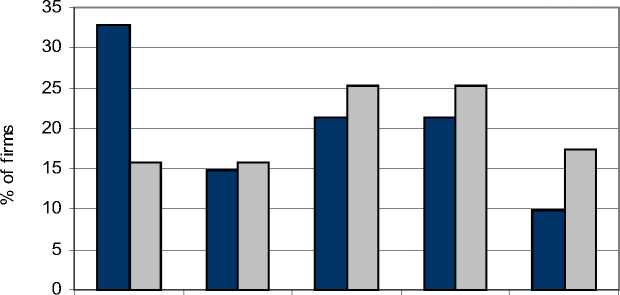18
firms located in the periphery, found to be statistical significant. However, only two of them
belong to the first or second priority group of barriers. All the others gained very low mean
score (less than 2.0) reflect the very limited effect they have on the ability to innovate.
The more important barrier in this context is the lack of skilled labor that as expected is more
serious in the periphery, than in the metropolitan area (see Figure 5). 42.9% of the firms in
the periphery indicate this barrier as very significant or crucial to the ability to innovate
instead of 31.1% of the firms located in the metropolitan area.
Figure 5: Distribution of traditional industries (0%) according to the importance they
ascribed to the lack of skilled personal as a barrier to innovation, by regions

no slightly moderately very crucial
significant significant significant significant
□ metropolitan □ periphery
The importance of highly skilled labor pull to the regional innovativeness has been proved in
many studies (Frenkel 2000, Ciccone and Hall, 1996). It is also evident that the absence of
high skilled personal in the peripheral zones is more common that in the central areas. Never
the less, it was interesting to convinced that firms belong to the traditional industry, in
particular in the peripheral zone, regards much more importance to the lack of highly skilled
labor, than does firms that located in the more central areas. Similar findings did not emerge
in the hi-tech firms in the sample. This is also exceptional due to fact that traditional
industries based in large extent on nonprofessional and cheep labor. The explanation to this
finding stemming from the unique structure of the traditional industries located in the
peripheral zone of the Northern region of Israel. In previous study (see Frenkel, 2000) it was
found that the rate of traditional industrial firms engage in innovation is higher among those
that located in the peripheral zone, than in the metropolitan area. As such the distribution of
More intriguing information
1. Delayed Manifestation of T ransurethral Syndrome as a Complication of T ransurethral Prostatic Resection2. The name is absent
3. SOME ISSUES IN LAND TENURE, OWNERSHIP AND CONTROL IN DISPERSED VS. CONCENTRATED AGRICULTURE
4. Flatliners: Ideology and Rational Learning in the Diffusion of the Flat Tax
5. The name is absent
6. Mergers and the changing landscape of commercial banking (Part II)
7. Regional differentiation in the Russian federation: A cluster-based typification
8. Visual Artists Between Cultural Demand and Economic Subsistence. Empirical Findings From Berlin.
9. The name is absent
10. The name is absent